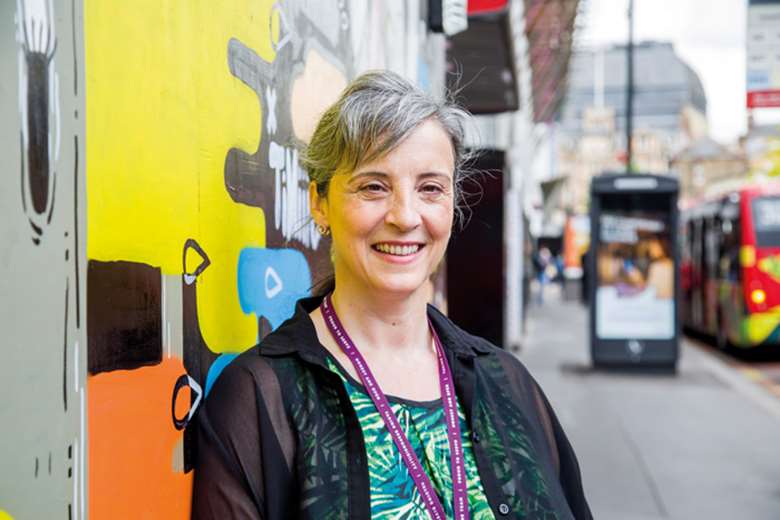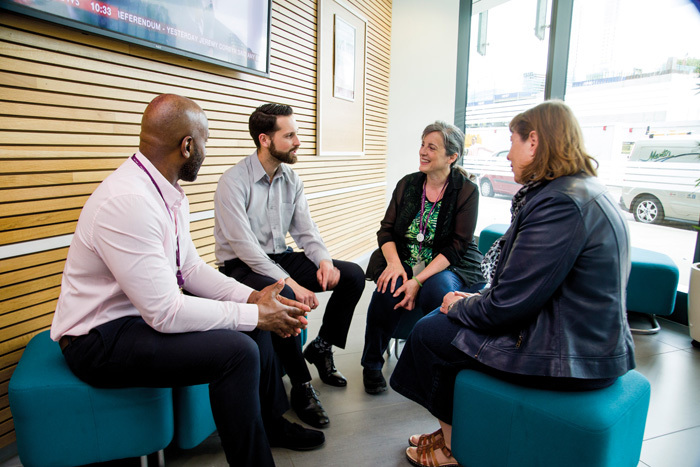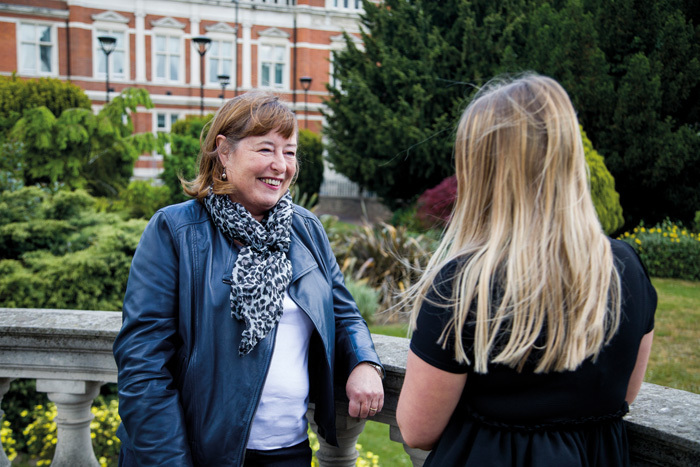Independent visitors: Volunteers help children in care
Catherine Pestano
Monday, June 24, 2019
Independent visitors provide vital support to children in care. Catherine Pestano, who helps co-ordinate a network of nearly 80 volunteers in Croydon, south London, describes a typical week for the service.

MONDAY
8AM It's a sunny summer's morning and I am planning a day in the office. As an independent visitor volunteer co-ordinator for Croydon Council's service my role involves co-ordinating a network of volunteers who visit and mentor children in care. I recruit, train and supervise volunteers and work closely with my colleagues in children's social services. No two weeks are the same.
As we have hot-desking, I know I need to arrive early to be sure of getting my preferred seat. I set up my computer and start planning my week. As it's quiet, I take the opportunity to catch up with one of the independent reviewing officers (IRO) I sit near and update her on how some of her young people are getting on with their independent visitors (IVs).
This week we have one of our training courses to recruit new IVs. These happen three times a year and involve quite a bit of preparation. I update the slides and print off handouts, and check in with our guest speakers. I am always surprised at the number and diversity of the amazing people who step forward to volunteer to help our young people in care and look forward to these training sessions.
9AM I send some publicity about the IV service to a new online recruitment partner that focuses on cool things you can do in Croydon. We have tried many different ways to recruit over the years and our message has gradually become more targeted using messages such as "work with young asylum seekers" or "support children in care". We find this reaches those who truly want to help others rather than simply gaining experience for a job. We need people who will hang in there when the going gets tough and support a child for as long as the child needs.
 Independent visitors meet quarterly for support. Picture: Alex Deverill
Independent visitors meet quarterly for support. Picture: Alex Deverill
11AM Now for the best bit of the job. Looking at the children on our waiting list, I arrange to visit two siblings aged six and eight and their foster carers to tell them about having an IV. Six is the youngest age we serve. The IRO has said this pair are very bright and each would really benefit from some extra one-to-one attention.
I also make a call about another young person, who I am trying to match with a new IV. She was keen to have someone from a similar ethnic background, but was not happy with her original match, feeling they did not have much in common. We always try and meet the young person's wishes but also need to consider their best interests. In this case, finding an ethnic match would have meant a much longer wait but we do have an IV available who has lots of interests in common with this girl. We offered her the choice and she has decided to give it a go. We've suggested she tries three visits and lets us know if she is happy to continue.
12NOON I open my post and find some IV expenses to process. We make this a priority as they should never be out of pocket for long. I check my email and have been sent some diaries of outings from some of the IVs I line-manage.
Looked-after children often have more restricted social networks and opportunities than their peers. The IV service provides a chance to do new things, get away from any difficulties they may be experiencing and just be a kid and this comes across in the diaries, which document moments of joyful ordinariness, hanging out, making jokes.
One diary in particular is quite moving as a young man who is in trouble every week at school for angry outbursts and a defiant attitude is spoken of so warmly by his IV. "I do so enjoy being out with this gentle, polite boy," writes the IV. I upload the diaries to each child's file as these will make a lovely record they can access when they're older.
2PM After lunch, I report to a multi-agency strategy meeting about a trafficked young person at risk of child criminal exploitation who is being supported by one of our IVs. The girl has been acting suspiciously with more money than would be expected and there are fears she has been taking drugs. This is a tricky situation for our service to negotiate as our volunteers are not there to spy on the young people. Despite having a positive relationship with her IV the girl has been reluctant to meet up and talk to them of late. Nevertheless, our volunteer is keen to keep trying to reach out to this lonely and troubled young person.
TUESDAY
1PM I come in late today ahead of a training session this evening and buy refreshments for the session on the way in. My first task is to prepare a room and papers for an initial interview with a prospective volunteer and the interview panel afterwards.
1.30PM The prospective volunteer arrives. I have already had a telephone conversation about the role with this person. The meeting today is a structured one-to-one interview to draw out the volunteer's motivation. Sometimes people want to become a volunteer to help them deal with or recover from their own personal issues. This man has had relationship problems in the past but it is clear he has done some in-depth work on this and now has a lot to offer. He is confirmed as participating in the training.
3PM I chat with former looked-after young person Sasha*, who will be taking part in tonight's training session by sharing her experiences of having an IV. She moved placement 12 times from the ages of 15 to 18. "My independent visitor was the one person who seemed to care about me and who I felt I could talk to, about nothing really, just spending happy time together," she explains.
4PM I visit a young person and their foster carer to explain the IV service. The young person fills out a form setting out their wishes and interests to help us try and find the right IV for them. IVs are not told a child's full backstory - only about any current risks - whichmeans children are free to just be themselves and escape past difficulties. They are often surprised to learn people do this for free, just to be kind.
5.45PM I deliver training to a group of 22 new potential IVs. This session is about what it is like to be in care. One of the guest speakers is a social worker who shares inspiring stories about how to connect with young people and the positive difference this can make. A senior manager visits to thank people and emphasise how important and valuable the role is. We end at 8.30pm and I pack up, leaving just before 9pm.
 Volunteers like Marian Cassidy are committed to meeting young people regularly to do a variety of activities. Picture: Alex Deverill
Volunteers like Marian Cassidy are committed to meeting young people regularly to do a variety of activities. Picture: Alex Deverill
WEDNESDAY
11AM I open the team email inbox to see if anyone has expressed an interest in becoming an IV and am pleased to find an interesting range of people have got in touch. I call those who provided a contact number and send out information sheets and application forms to all those who made enquiries.
We ask people to commit to meeting up with a young person every fortnight. It's a big ask. When I talk to people about becoming an IV I ask them to think about whether there are likely to be any major changes in their circumstances within the next couple of years and whether their family can spare them.
Disappointingly, about a third of people who express an interest decide they can't make that commitment. However, it is better they decide that now than after I have matched them with a child.
12NOON I run a formal interview panel with a social worker. This is the final stage and comes after the IV training. The interview is based on real-life scenarios and designed to test whether applicants can think on their feet. Forexample, one question explores what they would do if a youngpersonsaid they might be gay and had feelings for a friend. We hopetheapplicant would be accepting and supportive, but would also enquirewhothis "friend" was and how they met. The online world can beparticularlyrisky for our young people.
1.45PM I check our electronic referrals inbox. Social workers used to find our referral process too time-consuming but we worked with our IT team to make it much quicker and easier. This halved the time for making referrals.
2.15PM I have a catch-up meeting with a fellow IV co-ordinator to discuss referrals that have come in. We identify some where we have concerns about whether the child is ready for an IV. These could be practical concerns like whether a child will follow instructions when crossing the road or concerns that a young person does not really want the service at the moment. There is also one case where radicalisation is a potential risk so we would need to bear that in mind when making a match.
3PM The social work team is close by so I stroll round to have a face-to-face chat about a referral where the child has some learning and behavioural needs. We discuss the levels of risk and decide to leave it for the moment but agree to review this in three months' time when the child is more settled in their foster placement.
3.45PM I look through some photos from a recent group outing. We organise group outings about four times a year for the young people and their IVs. It is always wonderful to see them get together, swap numbers and arrange other joint trips. This time we went to a local woodland and pond where we did woodcraft activities and toasted marshmallows around a camp fire.
4.30PM There is a matching visit with a young person who has had to move quite far from home. Fortunately I have found an IV willing to travel to see them. The young person has some concerns about connecting with someone new so I know I'll need to keep a close eye on this match. We arrange a date for them to meet up.
THURSDAY
9AM I take a call from an IV who is seriously unwell and unexpectedly needs to quit. We plan how best to support the child in question who is going through a difficult transition from primary to secondary school. The IV agrees to write a card to the girl explaining why she can't continue. I will link up with the child's social worker and go and visit her. I begin thinking about other IVs I have available.
11AM I start drafting a newsletter for IVs to ask what topics they would like to cover in our next quarterly training and networking session. I also want to find out who is up for coming to our next group activity - a cooking session where IVs and their young people prepare a meal together.
12.15PM I attend a corporate induction session for new council workers to promote the IV service. Some of our best IVs have come from within the authority.
1.30PM An IV calls with a concern about their last visit when they noticed the child had extra money and an extra mobile phone. The suggestion is the child, who has a learning disability, may be at risk of child criminal exploitation so I immediately make contact with the child's social worker and IRO.
2.30PM As part of my role I liaise with regional and national IV networks, which are a great source of support given the independent nature of our work and the fact most IV teams and services are small. We help each other with ideas, problem solving and share best practice.
3.30PM During supervision with my manager we discuss a tricky issue that came up when I visited a young asylum seeker to offer her an IV. Through her interpreter, she made a complaint about an independent fostering agency so we discuss how best to support the young person and ensure the complaint is looked into.
FRIDAY
I have a day off today because we have group training tomorrow. We recently changed our training model from all evenings to including a full Saturday, which people seem to enjoy.
SATURDAY
Today's training is a mix of presentations and guest speakers, broken up with games and discussion.
We explore a range of topics including safeguarding, confidentiality and communication. The training also covers loss and includes a powerful practical exercise that shows the things that matter to a child and how many of these are lost or reduced once they come into care. This stays with people and even if they don't go on to become IVs they will leave with a deeper understanding of the challenges faced by this vulnerable group.
At the final session next week applicants will get to hear from current IVs and their young people about the life-changing difference the service can make.
WHAT IS AN INDEPENDENT VISITOR?
The role of independent visitor (IV) for looked-after children was created under the Children Act 1989.
Under the legislation, children and young people in care who have little or no contact with their birth parents should be offered the chance to have an adult in their lives who can give them support and advice and take an interest in them. The 2008 Children and Young People's Act went further by underlining that all children in care have the right to an IV.
The role has a safeguarding element, providing an independent person outside care placements and children's social services to look out for a child or young person. It is also a befriending role aimed at enabling a child to relax and have fun without an agenda.
IVs are male or female volunteers, usually aged 18 or over, who meet regularly with a child or young person to do a fun or interesting activity chosen by the child. IVs get training and are asked to commit to supporting a child for at least a year. Many relationships last longer.
Not all looked-after children need or want an IV. Under the legislation, local authorities should consider referring a child to an IV service when contact with a parent - or those with parental responsibility - has been patchy or not taken place within the past year. Referrals should also be made when having some extra support or mentoring is thought to be in the best interests of the child. The service is optional and children and young people decide whether or not to take it up. Any looked-after child can request to have an IV. The local authority must take into account the feelings and wishes of the child when matching them with an adult volunteer.
Legislation and the format of IV services differ across the four UK nations. Offering access to an IV is a statutory duty in England and Wales and most authorities now make some provision either in-house or through an external provider. However, 2016 research by the charity Barnardo's - which included a Freedom of Information survey of local authorities in England - indicated only 3.2 per cent of looked-after children had an IV.
FACTFILE
CROYDON'S INDEPENDENT VISITOR SERVICE
When did the service start?
The service launched in December 2000 with an external contract. It was taken in-house in 2002 and has grown over the years.
Where is it based?
Croydon Council's IV service is based in the Children's Quality Assurance Service in central Croydon. However, it has a separate line management structure to children's social workers to support independence.
Who is in the team?
Until recently, the service had 1.5 independent volunteer visitor co-ordinator posts, plus a part-time business support role. As of this month, this will increase to 3.5 co-ordinator roles plus business support. There are currently 79 volunteers.
How many children and young people does the service work with each year?
Croydon currently provides 10 per cent of its looked-after children with an IV, which is the national target. Increased staffing from this summer will allow the service to exceed that and support 126 matches.
What training do volunteers get?
Twelve hours of initial training on what it means to be a looked-after child, loss, safeguarding, communication and the practicalities of being an IV. IVs attend quarterly meetings offering additional training and topics for discussion. In addition, IVs can access a wide range of online and free local training.
How many children and young people does each volunteer see?
Volunteers usually work with just one child at a time, although some have two matches.
How is the service funded?
From the main children's service's budget.
How much does it cost per year?
Direct costs include the co-ordinator roles at about £42,000 per year each with expenses and business support at around £20,000 a year. The costs for activities and travel are approximately £600 per year per child. Indirect costs include interpreters, management, training, finance and office costs.
www.barnardos.org.uk/national-independentvisitor-data-report.pdf




